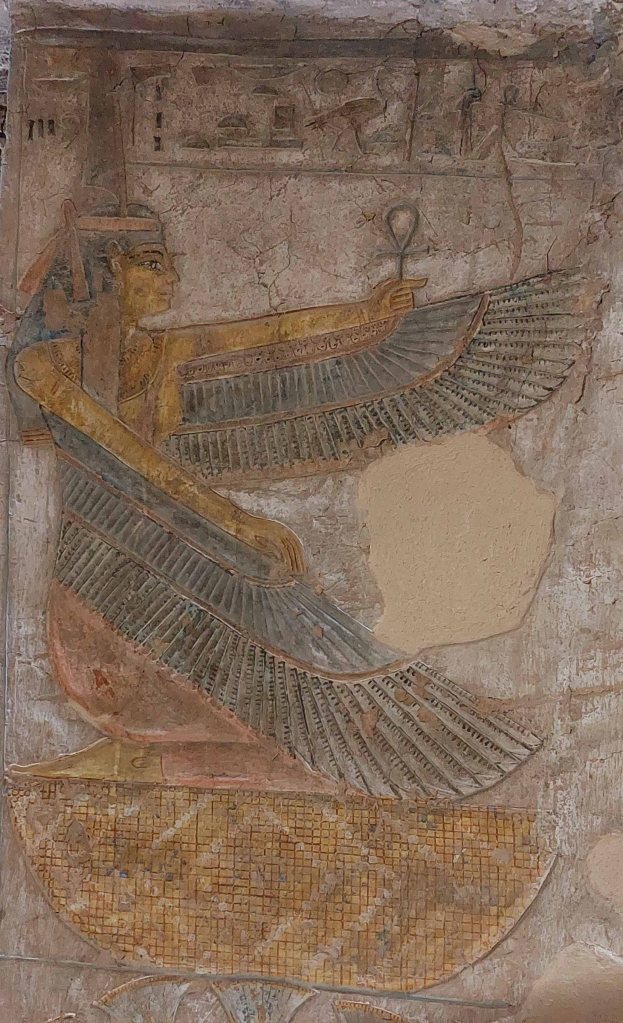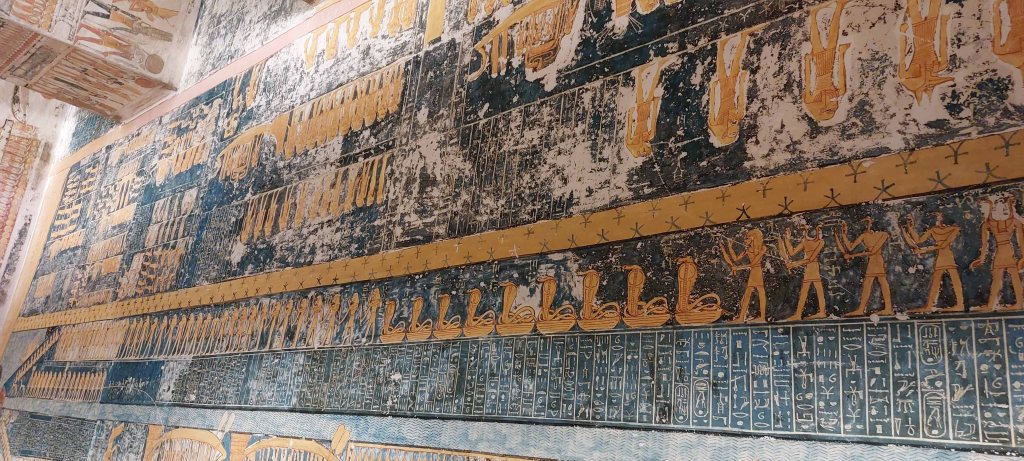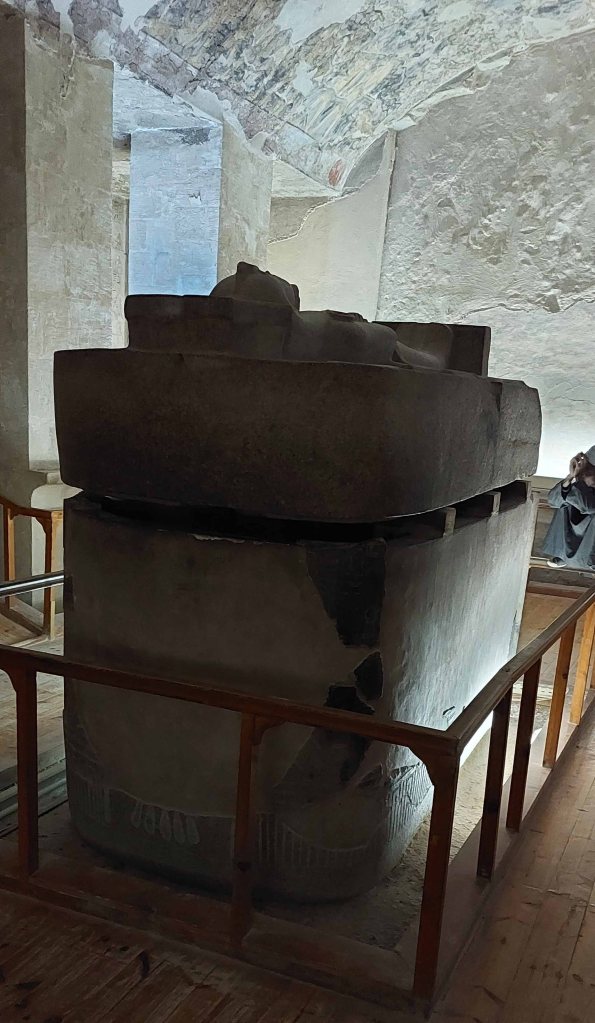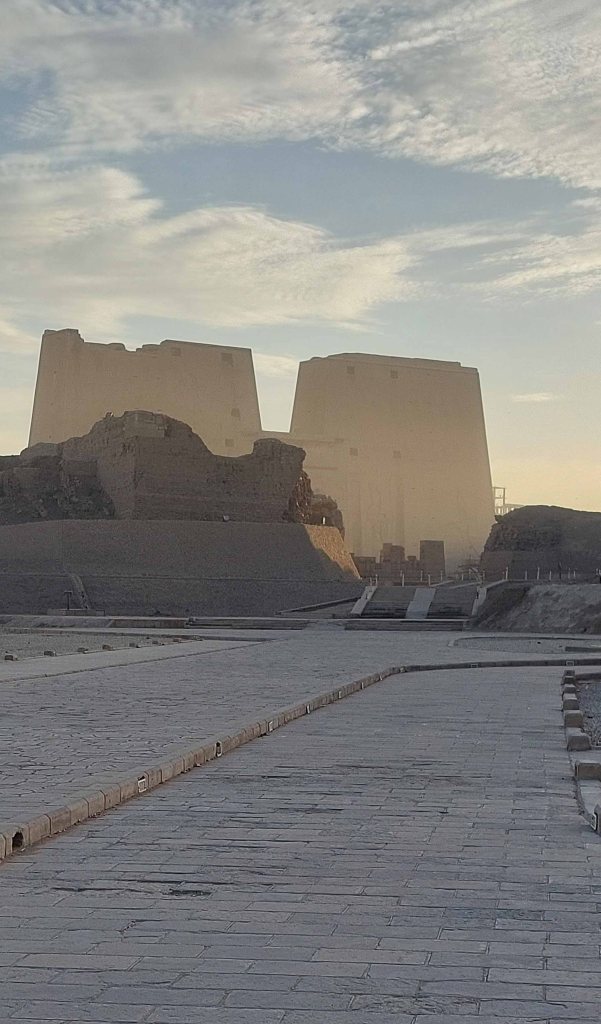After Luxor, the next morning we were out the door very early to experience the Valley of the Kings and the Mortuary temple of Queen Hatshepsut. We left early to avoid mid-day heat – the area is known as one of the hottest places on earth. It lies in a valley to the west of Luxor.
The Valley of the Kings includes at least 65 royal tombs. They were dug into the mountainsides, and can be quite extensive. They are noted for the remarkable condition of the painted reliefs – which have never been exposed to direct sunlight.


The tombs are intended to help the soul of the pharaoh complete the journey from this life to the next. The walls and ceilings are completely filled with memories of his life, and after life myths and traditions all ancient Egyptians knew as essential to successfully make the transition to the next life.
Ancient Egyptians believed that their Earthly existence was merely a transitional phase. They believed that if they lived this life following the principles of ma’at, they might make it past this phase. The goddess Ma’at put forth 42 commandments by which all lived. These were more extensive than the 10 Commandments of Moses, and existed for thousands of years prior. Today, it is worth reflecting that most societies and laws still align with many of these values.
When an ancient Egyptian died, its soul awoke in the Duat. The Duat was the underworld – a place inhabited by the deities Osiris, Nekhbet, Ma’at, Anubis, and Hathor, as well as the souls of others undertaking the journey to the next life. This journey often took place on a raft. Osiris granted or denied entry to the next life. Anubis and Afu Ra helped the soul on its way. It was also a difficult realm, filled with demons and serpents who’d challenge the soul. After making it past all these challenges, the soul made it to a place where it would face judgment by Osiris. There, countless other souls waited their turn. Ordinary Egyptians hoped to ascend to the “Field of Rushes,” where they’d sow and harvest abundant crops into eternity. But the pharaoh, his spirit would unite with the Sun god Ra, ascend into the sky and take its place amongst the stars. Everyone was guided across the duat by the ram headed duat form of Ra – Afu Ra. If they made it to the other side of the duat, the deceased faced a “tribunal” over which Osiris presided. It would have to recite 42 “negative confessions,” meaning they’d say “I did not” engage in each of the 42 rules – e.g. “I have not been an evesdropper.” Then, a scale of worth is presented. This scale has on one side the ostrich feather of Ma’at. The feather of truth. On the other side is placed the heart of the deceased. The ancient Egyptians did not know Hell as Jews, Christians and Muslims know Hell. Instead, the worst would be to cease to exist at all. Once the heart was placed on the scale, if it was lighter than the feather, the soul could go to the afterlife. If not, if heavier, the soul’s heart was fed to a crocodile/hippo monster and extinguished for eternity.
Upon awakening after death, prior to journeying the duat, the soul might not know its identity. To help out, Egyptians decorated the tomb walls with scenes from its Earthly life. We visited the tomb of Ramses IX. This image is such a scene of his life. When pharaohs were crowned, they presented an image of Ma’at to the highest god Amun – assuring him that the pharoah would ensure balance and harmony.
The importance of truth and the principles of ma’at cannot be overstated.
Inside the tomb, images of Ma’at guard its entrance and appear many times over. There is a scene of Ma’at with a harpist, and one of her with the sun god Ra.



The soul would ride on a raft through the Duat. Nephthys would oversee.


Some gods would appear differently in the Duat phase. Here is Afu Ra, how the sun god Ra appears in the Duat.

We are now in the chamber where the sarcophagus is located. Along the walls are more scenes from the journey through the Duat. We see the soul being challenged by serpents. We see the representation of the journey through out the night. The goddess Nut covers the ceiling from one side to the other. She oversees the stars. Beneath her elongated body are more scenes from challenges the soul faces on its way.



From an artistic and engineering point of view, the tomb is fantastic. Here is a video!
In the center lay the sarcophagus, which must weigh tons.

OK, hamming it up like Indiana Jones!


















